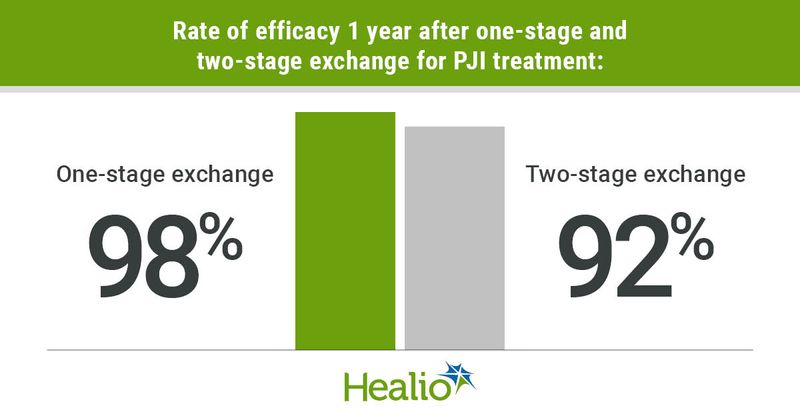One-stage approach for PJI treatment had similar success rates as two-stage approach
Key takeaways:
- One-stage approach for periprosthetic joint infection had an efficacy of 98% vs. 92% for two-stage approach.
- One-stage treatment had nearly four times the amount of success after adjusting for comorbidities.
GRAPEVINE, Texas — One-stage and two-stage exchange for treatment of periprosthetic joint infection had similar success rates at 1 year, according to interim results presented here.
“While these results are encouraging about one-stage treatment, the caveat is this is 1-year follow-up only,” Thomas K. Fehring, MD, said during his presentation at the American Association of Hip and Knee Surgeons Annual Meeting.

Fehring and colleagues randomly assigned 321 patients with chronically infected primary hip and knee arthroplasties to undergo either one-stage (n=164) or two-stage (n=157) exchange. Fehring said all patients underwent a double surgical setup, similar irrigation protocols, 6 weeks of IV antibiotics followed by 6 months of oral antibiotics post-reimplantation.

Among 273 patients included in the 1-year interim results, Fehring said one-stage exchange had an efficacy of 98% and two-stage exchange had an efficacy of 92%.
“To answer the question does comorbidity affect infection rates, comorbidity classification was similar between groups, but after adjusting for comorbidities, one-stage treatment had nearly four times the amount of success,” Fehring said.
No patients in either group had organism resistance, according to Fehring. He added after adjusting for organism resistance, patients in the one-stage exchange group had nearly four times the odds of success. Although patients in the two-stage exchange group had a slightly higher draining sinus, Fehring said one-stage exchange had nearly 3.5 times the odds of success after adjusting for draining sinus.
“If we look at the adverse events, there was a higher risk of acute kidney injury in the two-stage group compared to the one-stage group,” Fehring said.

